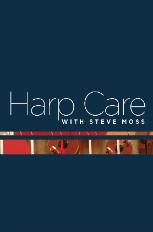[vimeo 4214699]
During a harp care class I gave at Lyon & Healy West in Salt Lake City, one of the attendees, Michele Rasmussen, was kind enough to shoot a few videos of me demonstrating some techniques for replacing harp strings. The videos came out great so I thought I’d post them here and include some additional explanation as well. The first one is shown above. You can find the next one here.
For a much more comprehensive demonstration of string replacement, Check out my DVD: Harp Care with Steve Moss. You’ll be restringing like the pros in no time.
Click here to learn more about the DVD.
The technique shown in this video applies to the first, second, and third octaves (and the “zero octave” F and G strings at the top of some harps). For these octaves, it’s important to use some kind of anchor that is thicker than the string you’re using, to insure that the string knot doesn’t pull into the hole and get stuck there. Trust me, you don’t want THAT to happen!
My anchor of choice is a one inch (2.5 cm) piece of 5th octave A,B, or C string, the three thickest gut strings on the harp. At Lyon & Healy we were trained that only these three strings were thick enough to provide a stable anchor. I haven’t tested this for myself, but I have seen instances where harps were anchored with thinner strings, and you can see them bend under the string tension. If they’re bending, do you think that string is going to stay in tune?
The video shows how I tie the knot around the anchor. I’m using a piece of nylon here. The same technique works for gut strings, but they’re a little trickier to work with because they’re stiffer. Stay tuned for another video in this series where I demonstrate tying 4th and 5th octave string knots. There, I use a gut string and you can see the technique for breaking the integrity of the gut fibers so you can form the necessary loops for your knot. If you don’t want to wait for that blog post, you can watch all three videos now on this web page.


Thanks for putting this video up! What a tremendous tool–teach a man to fish…
I’m going to point all my students to this website–because I may show them this when they break a string, but by the next break they’ve forgotten. When I broke my first string on my harp in 1984 I sat with a diagram and cussed and swore for 2 days. No internet back then!
You’re welcome, Kathy. Thank YOU for the feedback.
Steve
Very helpful; I am just teaching myself to string my harps; and I think this is very clear; no matter how carefully I followed diagrams for stringing, the strings might not wind toward the neck; or I might not trap the short end of the string under the long end; so thank you; just restrung a John Thomas Welsh harp, that had caused me many troubles previously. Thanks
You’re welcome. I’m just finishing up a DVD called “Harp Care with Steve Moss,” which covers string replacement, tuning, cleaning and moving pedal and lever harps. More details coming soon!
I have endless trouble knotting harp strings, so please let, me know how Ican purchase your book.
It is a DVD, actually. You can click its picture on the left side of this or any other page on this blog, which will take you to a page where you can order it.
Please let me know how to purchase your book.
Spot on with this write-up, I really suppose this website wants rather more consideration. I’ll in all probability be once more to learn way more, thanks for that info.
steve is your dvd still available? I have a string stuck in a hole. Can you recommend a technician in cleveland ohio or what should I do?
Yes, Kim, the DVD is available. Click the the picture of it on any of my blog pages to learn more.
The closest technician to Cleveland is Tom Bell. I believe he’s in Akron. If you can get any grip at all on the string knot inside the body, you might be able to fasten some vise grip pliers and pry it out. Do this only on the underside! I’d try that before recommending anything more tricky. Good luck.
it didn’t work. we are left with trying to drill it out. Tom Bell appears to be a national technician, and no one is calling me back from their offices. Is he the only one in Northeast Ohio? Hey note to all technicians, there appears to be a great need for you in the Ohio area since it looks like there is only one very busy person available in this area, as I learned after making many calls today.
Pretty sure he’s the only one based in Ohio. Lyon & Healy technicians come through Cleveland in the fall.
Take it slow with the drill, but that was the next thing I was going to suggest that you try. Be cautious. It is easier than you think for the drill to wander and you can end up with two holes and your string still stuck. Don’t ask me how I know this…
I managed to get it out with a small nail I kept pushing through and pulling back out with needle-nosed pliers and a tiny drop of oil; I removed the small metal support around the hole too which I carefully replaced. it pushed out finally.
You were very helpful. I see that Lyon and Healy will be coming through and I inquired about getting my harp regulated. Thanks again for your help.
You’re welcome, Kim. Glad it worked out okay with the string.
Thank You – I really needed to see more clearly than diagram.